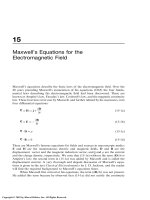- Trang chủ >>
- Khoa Học Tự Nhiên >>
- Vật lý
Introduction to optical waveguide analysis solving maxwell's equation and the schrdinger equation kenji kawano, tsutomu kitoh
Bạn đang xem bản rút gọn của tài liệu. Xem và tải ngay bản đầy đủ của tài liệu tại đây (1.33 MB, 280 trang )
INTRODUCTION TO
OPTICAL WAVEGUIDE
ANALYSIS
Introduction to Optical Waveguide Analysis: Solving Maxwell's Equations
and the SchroÈdinger Equation. Kenji Kawano, Tsutomu Kitoh
Copyright # 2001 John Wiley & Sons, Inc.
ISBNs: 0-471-40634-1 (Hardback); 0-471-22160-0 (Electronic)
INTRODUCTION TO
OPTICAL WAVEGUIDE
ANALYSIS
Solving Maxwell's Equations and
the Schro
È
dinger Equation
KENJI KAWANO and TSUTOMU KITOH
A Wiley-Interscience Publication
JOHN WILEY & SONS, INC.
New York / Chichester / Weinheim / Brisbane / Singapore / Toronto
Designations used by companies to distinguish their products are often claimed as trademarks. In all
instances where John Wiley & Sons, Inc., is aware of a claim, the product names appear in initial
capital or ALL CAPITAL LETTERS. Readers, however, should contact the appropriate companies
for more complete information regarding trademarks and registration.
Copyright # 2001 by John Wiley & Sons, Inc. All rights reserved.
No part of this publication may be reproduced, stored in a retrieval system or transmitted in any
form or by any means, electronic or mechanical, including uploading, downloading, printing,
decompiling, recording or otherwise, except as permitted under Sections 107 or 108 of the 1976
United States Copyright Act, without the prior written permission of the Publisher. Requests
to the Publisher for permission should be addressed to the Permissions Department, John Wiley &
Sons, Inc., 605 Third Avenue, New York, NY 10158-0012, (212) 850-6011, fax (212) 850-6008,
E-Mail: PERMREQ @ WILEY.COM.
This publication is designed to provide accurate and authoritative information in regard to the
subject matter covered. It is sold with the understanding that the publisher is not engaged in rendering
professional services. If professional advice or other expert assistance is required, the services
of a competent professional person should be sought.
ISBN 0-471-22160-0
This title is also available in print as ISBN 0-471-40634-1.
For more information about Wiley products, visit our web site at www.Wiley.com.
To our wives,
Mariko and Kumiko
CONTENTS
Preface = xi
1 Fundamental Equations 1
1.1 Maxwell's Equations = 1
1.2 Wave Equations = 3
1.3 Poynting Vectors = 7
1.4 Boundary Conditions for Electromagnetic Fields = 9
Problems = 10
Reference = 12
2 Analytical Methods 13
2.1 Method for a Three-Layer Slab Optical Waveguide = 13
2.2 Effective Index Method = 20
2.3 Marcatili's Method = 23
2.4 Method for an Optical Fiber = 36
Problems = 55
References = 57
vii
3 Finite-Element Methods 59
3.1 Variational Method = 59
3.2 Galerkin Method = 68
3.3 Area Coordinates and Triangular Elements = 72
3.4 Derivation of Eigenvalue Matrix Equations = 84
3.5 Matrix Elements = 89
3.6 Programming = 105
3.7 Boundary Conditions = 110
Problems = 113
References = 115
4 Finite-Difference Methods 117
4.1 Finite-Difference Approximations = 118
4.2 Wave Equations = 120
4.3 Finite-Difference Expressions of Wave Equations = 127
4.4 Programming = 150
4.5 Boundary Conditions = 153
4.6 Numerical Example = 160
Problems = 161
References = 164
5 Beam Propagation Methods 165
5.1 Fast Fourier Transform Beam Propagation Method = 165
5.2 Finite-Difference Beam Propagation Method = 180
5.3 Wide-Angle Analysis Using Pade
Â
Approximant
Operators = 204
5.4 Three-Dimensional Semivectorial Analysis = 216
5.5 Three-Dimensional Fully Vectorial Analysis = 222
Problems = 227
References = 230
6 Finite-Difference Time-Domain Method 233
6.1 Discretization of Electromagnetic Fields = 233
6.2 Stability Condition = 239
6.3 Absorbing Boundary Conditions = 241
viii CONTENTS
Problems = 245
References = 249
7 Schro
È
dinger Equation 251
7.1 Time-Dependent State = 251
7.2 Finite-Difference Analysis of Time-Independent State = 253
7.3 Finite-Element Analysis of Time-Independent State = 254
References = 263
Appendix A Vectorial Formulas 265
Appendix B Integration Formula for Area Coordinates 267
Index 273
CONTENTS ix
PREFACE
This book was originally published in Japanese in October 1998 with the
intention of providing a straightforward presentation of the sophisticated
techniques used in optical waveguide analyses. Apparently, we were
successful because the Japanese version has been well accepted by
students in undergraduate, postgraduate, and Ph.D. courses as well as
by researchers at universities and colleges and by researchers and
engineers in the private sector of the optoelectronics ®eld. Since we did
not want to change the fundamental presentation of the original, this
English version is, except for the newly added optical ®ber analyses and
problems, essentially a direct translation of the Japanese version.
Optical waveguide devices already play important roles in telecommu-
nications systems, and their importance will certainly grow in the future.
People considering which computer programs to use when designing
optical waveguide devices have two choices: develop their own or use
those available on the market. A thorough understanding of optical
waveguide analysis is, of course, indispensable if we are to develop our
own programs. And computer-aided design (CAD) software for optical
waveguides is available on the market. The CAD software can be used
more effectively by designers who understand the features of each analysis
method. Furthermore, an understanding of the wave equations and how
they are solved helps us understand the optical waveguides themselves.
Since each analysis method has its own features, different methods are
required for different targets. Thus, several kinds of analysis methods have
xi
to be mastered. Writing formal programs based on equations is risky
unless one knows the approximations used in deriving those equations, the
errors due to those approximations, and the stability of the solutions.
Mastering several kinds of analysis techniques in a short time is
dif®cult not only for beginners but also for busy researchers and
engineers. Indeed, it was when we found ourselves devoting substantial
effort to mastering various analysis techniques while at the same time
designing, fabricating, and measuring optical waveguide devices that we
saw the need for an easy-to-understand presentation of analysis techni-
ques.
This book is intended to guide the reader to a comprehensive under-
standing of optical waveguide analyses through self-study. It is important
to note that the intermediate processes in the mathematical manipulations
have not been omitted. The manipulations presented here are very detailed
so that they can be easily understood by readers who are not familiar with
them. Furthermore, the errors and stabilities of the solutions are discussed
as clearly and concisely as possible. Someone using this book as a
reference should be able to understand the papers in the ®eld, develop
programs, and even improve the conventional optical waveguide theories.
Which optical waveguide analyses should be mastered is also an
important consideration. Methods touted as superior have sometimes
proven to be inadequate with regard to their accuracy, the stability of
their solutions, and central processing unit (CPU) time they require. The
methods discussed in this book are ones widely accepted around the
world. Using them, we have developed programs we use on a daily basis
in our laboratories and con®rmed their accuracy, stability, and effective-
ness in terms of CPU time.
This book treats both analytical methods and numerical methods.
Chapter 1 summarizes Maxwell's equations, vectorial wave equations,
and the boundary conditions for electromagnetic ®elds. Chapter 2
discusses the analysis of a three-layer slab optical waveguide, the effective
index method, Marcatili's method, and the analysis of an optical ®ber.
Chapter 3 explains the widely utilized scalar ®nite-element method. It ®rst
discusses its basic theory and then derives the matrix elements in the
eigenvalue equation and explains how their calculation can be
programmed. Chapter 4 discusses the semivectorial ®nite-difference
method. It derives the fully vectorial and semivectorial wave equations,
discusses their relations, and then derives explicit expressions for the
quasi-TE and quasi-TM modes. It shows formulations of E
x
and H
y
expressions for the quasi-TE (transverse electric) mode and E
y
and H
x
expressions for the quasi-TM (transverse magnetic) mode. The none-
xii PREFACE
quidistant discretization scheme used in this chapter is more versatile than
the equidistant discretization reported by Stern. The discretization errors
due to these formulations are also discussed. Chapter 5 discusses beam
propagation methods for the design of two- and three-dimensional (2D,
3D) optical waveguides. Discussed here are the fast Fourier transform
beam propagation method (FFT-BPM), the ®nite-difference beam propa-
gation method (FD-BPM), the transparent boundary conditions, the wide-
angle FD-BPM using the Pade approximant operators, the 3D semi-
vectorial analysis based on the alternate-direction implicit method, and
the fully vectorial analysis. The concepts of these methods are discussed
in detail and their equations are derived. Also discussed are the error
factors of the FFT-BPM, the physical meaning of the Fresnel equation,
the problems with the wide-angle FFT-BPM, and the stability of the
FD-BPM. Chapter 6 discusses the ®nite-difference time-domain method
(FD-TDM). The FD-TDM is a little dif®cult to apply to 3D optical
waveguides from the viewpoint of computer memory and CPU time, but
it is an important analysis method and is applicable to 2D structures.
Covered in this chapter are the Yee lattice, explicit 3D difference
formulation, and absorbing boundary conditions. Quantum wells, which
are indispensable in semiconductor optoelectronic devices, cannot be
designed without solving the SchroÈdinger equation. Chapter 7 discusses
how to solve the SchroÈdinger equation with the effective mass approx-
imation. Since the structure of the SchroÈdinger equation is the same as that
of the optical wave equation, the techniques to solve the optical wave
equation can be used to solve the SchroÈdinger equation.
Space is saved by including only a few examples in this book. The
quasi-TEM and hybrid-mode analyses for the electrodes of microwave
integrated circuits and optical devices have also been omitted because of
space limitations. Finally, we should mention that readers are able to get
information on the vendors that provide CAD software for the numerical
methods discussed in this book from the Internet.
We hope this book will help people who want to master optical
waveguide analyses and will facilitate optoelectronics research and devel-
opment.
K
ENJI KAWANO and TSUTOMU KITOH
Kanagawa, Japan
March 2001
PREFACE xiii
INTRODUCTION TO
OPTICAL WAVEGUIDE
ANALYSIS
INDEX
Area coordinate, 74
Alternate-direction implicit (ADI) method,
216
Angular frequency, 3
Bandwidth, 109
Basis function, 62
Beam propagation method (BPM), 165
ADI-BPM, 216
®rst Fourier transform beam
propagation method (FFT-BPM),
165
®nite-difference beam propagation
method (FD-BPM), 180
Bessel function, 40
Bessel function of ®rst kind, 40
Bessel function of second kind, 40
modi®ed Bessel function of ®rst kind,
40
modi®ed Bessel function of second
kind, 40
Boundary condition, 9, 27, 110, 153, 197
absorbing boundary condition (ABC),
241
analytical boundary condition, 154
transparent boundary condition (TBC),
197
Characteristic equation, 17, 20, 41, 53
Charge density, 1
Cladding, 13, 37, 125
Core, 13, 37, 125
Cramer's formula, 76
Crank-Nicolson scheme, 195
Current density, 1
Cylindrical coordinate system, 38
Derivative, 119
®rst derivative, 119
second derivative, 119
Difference center, 131
hypothetical difference center, 131
Discretization, 130
equidistant discretization, 130
nonequidistant discretization, 130
Dirichlet condition, 66, 111, 153, 257
Dominant mode, 111
Effective index, 6
effective index method, 20
Eigenvalue, 88, 151
eigenvalue matrix equation, 68, 72, 151,
257
Eigenvector, 88, 151
Electric ®eld, 1
273
Electric ¯ux density, 1
Element, 64
triangular element, 64, 72
®rst-order triangular element, 64, 73,
91, 106
second-order triangular element, 64, 79,
95, 108
E
x
pq
mode, 24, 113
E
y
pq
mode, 31, 113
Even mode, 111
Expansion coef®cient, 63
Explicit scheme, 239
Finite-element method (FEM), 59
scalar ®nite-element method (SC-FEM),
59
Finite-difference method (FDM), 116
scalar ®nite-difference method
(SC-FDM), 150
semivectorial ®nite-difference method
(SV-FDM), 117
Finite-difference time-domain method
(FD-TDM), 233
Fourier transform, 170
discrete Fourier transform, 170
inverse discrete Fourier transform,
170
Fresnel approximation, 167±168, 187
Functional, 62
Fully vectorial analysis, 222
Galerkin method, 68
Helmholtz equaiotn, 5±7
Hybrid-mode analysis, 47
Implicit scheme, 186
Interpolation function, 64
Joule heating, 8
Laplacian, 4
Line element, 257
®rst-order line element, 257
second-order line element, 260
Local coordinate, 107, 110
LP mode, 38
Magnetic ®eld, 1
Magnetic ¯ux density, 1
Marcatili's method, 23
Maxwell's equations, 1
Matrix element, 89
Mirror-symmetrical plane, 111
Multistep method, 213
Neumann condition, 66, 111, 153, 257
Node, 64, 73, 79, 129, 257
Normalized frequency, 41
Odd mode, 111
Optical ®ber, 36
step-index optical ®ber, 37
Pade
Â
approximant operator, 204
Para-axial approximation, 167
Permeability, 1
relative permeability, 1
Permittivity, 1
relative permittivity, 1
Phase-shift lens, 170, 173
Phasor expression, 3
Plane wave, 10
Plank constant, 252
Potential, 252
Power con®nement factor (
G
factor),
55±56
Poynting vector, 7
Principal ®eld component, 125, 182, 184
Propagation constant, 6
Quantum well, 252
Quasi-TE mode, 125, 128
Quasi-TM mode, 125, 147
Rayleigh-Ritz method, 62
Reference index, 166, 187
Residual, 68
error residual, 68
weighted residual method, 69
SchroÈdinger equation, 251
normalized SchroÈdinger equation,
255
time-dependent SchroÈdinger equation,
251
274
INDEX
time-independent SchroÈdinger equation,
253±254
Shape function, 64, 78, 83
Slab optical waveguide, 13
Slowly varying envelope approximation
(SVEA), 166
Stability condition, 195, 239
Taylor series expansion, 118
Tohmas method, 203
Transverse electric (TE) mode, 14, 181,
186
Transverse magnetic (TM) mode, 14, 184,
190
Variational method, 59
Variational principle, 62
Wave equation, 5, 6
scalar wave equation, 84, 127
semivectorial wave equation, 124
vectorial wave equation, 4, 120
Wave number, 5
Weak form, 69
Wide-angle formulation, 167
Wide-angle analysis, 204
Wide-angle order, 205
Yee lattice, 235
INDEX 275
CHAPTER 1
FUNDAMENTAL EQUATIONS
This chapter summarizes Maxwell's equations, vectorial wave equations,
and the boundary conditions for electromagnetic ®elds.
1.1 MAXWELL'S EQUATIONS
The electric ®eld E (in volts per meter), the magnetic ®eld H (amperes per
meter), the electric ¯ux density D (coulombs for square meters), and the
magnetic ¯ux density B (amperes per square meter) are related to each
other through the equations
D eE; 1:1
B mH; 1:2
where the permittivity e and permeability m are de®ned as
e e
0
e
r
; 1:3
m m
0
m
r
: 1:4
Here, e
0
and m
0
are the permittivity and permeability of a vacuum, and e
r
and m
r
are the relative permittivity and permeability of the material. Since
the relative permeability m
r
is 1 for materials other than magnetic
1
Introduction to Optical Waveguide Analysis: Solving Maxwell's Equations
and the SchroÈdinger Equation. Kenji Kawano, Tsutomu Kitoh
Copyright # 2001 John Wiley & Sons, Inc.
ISBNs: 0-471-40634-1 (Hardback); 0-471-22160-0 (Electronic)
materials, it is assumed throughout this book to be 1. Denoting the
velocity of light in a vacuum as c
0
, we obtain
e
0
1
c
2
0
m
0
% 8:854188 Â10
À12
F=m 1:5
m
0
4p  10
À7
H=m: 1:6
The current density J (in amperes per square meter) in a conductive
material is given by
J sE: 1:7
The electromagnetic ®elds satisfy the following well-known Maxwell
equations [1]:
=3E À
@B
@t
; 1:8
=3H
@D
@t
J: 1:9
Since the equation =?=3A0 holds for an arbitrary vector A, from
Eqs. (1.8) and (1.9), we can easily derive
=?B 0; 1:10
=?D r: 1:11
The current density J is related to the charge density r (in coulombs per
square meter) as follows:
=?J À
@r
@t
: 1:12
Equations (1.10) and (1.11) can be derived from Eqs. (1.8), (1.9), and
(1.12).
2 FUNDAMENTAL EQUATIONS
1.2 WAVE EQUATIONS
Let us assume that an electromagnetic ®eld oscillates at a single angular
frequency o (in radians per meter). Vector A, which designates an
electromagnetic ®eld, is expressed as
Ar; tRef
Arexp jotg: 1:13
Using this form of representation, we can write the following phasor
expressions for the electric ®eld E, the magnetic ®eld H, the electric ¯ux
density D, and the magnetic ¯ux density B:
Er; tRef
Erexp jotg; 1:14
Hr; tRef
Hrexp jotg; 1:15
Dr; tRef
Drexp jotg; 1:16
Br; tRef
Brexp jotg: 1:17
In what follows, for simplicity we denote
E,
H,
D, and
B in the phasor
representation as E, H, D, and B. Using these expressions, we can write
Eqs. (1.8) to (1.11) as
=3E ÀjoB Àjom
0
H; 1:18
=3H joD joeE; 1:19
=?H 0; 1:20
=?e
r
E0; 1:21
where it is assumed that m
r
1 and r 0.
1.2.1 Wave Equation for Electric Field E
Applying a vectorial rotation operator =3 to Eq. (1.18), we get
=3=3EÀjom
0
=3H: 1:22
1.2 WAVE EQUATIONS 3
Using the vectorial formula
=3=3A==?AÀH
2
A; 1:23
we can rewrite the left-hand side of Eq. (1.22) as
==?EÀH
2
E: 1:24
The symbol H
2
is a Laplacian de®ned as
H
2
@
2
@x
2
@
2
@y
2
@
2
@z
2
: 1:25
Since Eq. (1.21) can be rewritten as
=?e
r
E=e
r
? E e
r
=?E 0;
we obtain
=?E À
=e
r
e
r
? E: 1:26
Thus, the left-hand side of Eq. (1.22) becomes
À=
=e
r
e
r
? E
À H
2
E: 1:27
On the other hand, using Eq. (1.19), we get for the right-hand side of
Eq. (1.22)
k
2
0
e
r
E; 1:28
where k
0
is the wave number in a vacuum and is expressed as
k
0
o
e
0
m
0
p
o
c
0
: 1:29
4 FUNDAMENTAL EQUATIONS
Thus, for a medium with the relative permittivity e
r
, the vectorial wave
equation for the electric ®eld E is
H
2
E =
=e
r
e
r
? E
k
2
0
e
r
E 0: 1:30
And using the wave number k in that medium, given by
k k
0
n k
0
e
r
p
o
e
0
e
r
m
0
p
o
em
0
p
; 1:31
we can rewrite Eq. (1.30) as
H
2
E =
=e
r
e
r
? E
k
2
E 0: 1:32
When the relative permittivity e
r
is constant in the medium, this
vectorial wave equation can be reduced to the Helmholtz equation
H
2
E k
2
E 0: 1:33
1.2.2 Wave Equation for Magnetic Field H
Applying the vectorial rotation operator =3 to Eq. (1.19), we get
=3=3Hjoe
0
=3e
r
E:
Thus,
==?HÀH
2
H joe
0
=e
r
3E e
r
=3E
joe
0
=e
r
3Ejoe
0
e
r
Àjom
0
H
joe
0
=e
r
3Ek
2
0
e
r
H: 1:34
Using
E
1
joe
0
e
r
=3H 1:35
1.2 WAVE EQUATIONS 5
obtained from Eqs. (1.19) and (1.20), we get from Eq. (1.30) the following
vectorial wave equation for the magnetic ®eld H:
H
2
H
=e
r
e
r
3=3Hk
2
0
e
r
H 0: 1:36
Using Eq. (1.31), we can rewrite Eq. (1.36) as
H
2
H
=e
r
e
r
3=3Hk
2
H 0: 1:37
When the relative permittivity e
r
is constant in the medium, this
vectorial wave equation can be reduced to the Helmholtz equation
H
2
H k
2
H 0: 1:38
Now, we discuss an optical waveguide whose structure is uniform in the
z direction. The derivative of an electromagnetic ®eld with respect to the z
coordinate is constant such that
@
@z
Àjb; 1:39
where b is the propagation constant and is the z-directed component of the
wave number k. The ratio of the propagation constant in the medium, b,to
the wave number in a vacuum, k
0
, is called the effective index:
n
eff
b
k
0
: 1:40
When l
0
is the wavelength in a vacuum,
b
2p
l
0
n
eff
2p
l
0
=n
eff
2p
l
eff
; 1:41
where l
eff
l
0
=n
eff
is the z-directed component of the wavelength in the
medium. The physical meaning of the propagation constant b is the phase
rotation per unit propagation distance. Thus, the effective index n
eff
can be
interpreted as the ratio of a wavelength in the medium to the wavelength in
a vacuum, or as the ratio of a phase rotation in the medium to the phase
rotation in a vacuum.
6 FUNDAMENTAL EQUATIONS
We can summarize the Helmholtz equation for the electric ®eld E as
H
2
c
E k
2
À b
2
E 0 1:42
or
H
2
c
E k
2
0
e
r
À n
2
eff
E 0: 1:43
For the magnetic ®eld H, on the other hand, we get the Helmholtz equation
H
2
c
H k
2
À b
2
H 0 1:44
or
H
2
c
H k
2
0
e
r
À n
2
eff
H 0; 1:45
where we used the de®nition H
2
c
@
2
=@x
2
@
2
=@y
2
.
1.3 POYNTING VECTORS
In this section, the time-dependent electric and magnetic ®elds are
expressed as Er; t and Hr; t, and the time-independent electric and
magnetic ®elds are expressed as
Er and
Hr. Because the voltage is the
integral of an electric ®eld and because the magnetic ®eld is created by a
current, the product of the electric ®eld and the magnetic ®eld is related to
the energy of the electromagnetic ®elds. Applying a divergence operator
=? to E3H, we get
=?E3HH ?=3E E ?=3H:
Substituting Maxwell's equations (1.8) and (1.9) into this equation, we get
=?E3HÀmH ?
@H
@t
À eE ?
@H
@t
À sE
2
À
@
@t
1
2
eE
2
1
2
mH
2
À sE
2
: 1:46
1.3 POYNTI NG VECTORS 7
When Eq. (1.46) is integrated over a volume V, we get
V
=?E3H dV
S
E3H
n
dS
À
@
@t
V
1
2
eE
2
1
2
mH
2
dV À
V
sE
2
dV ;
1:47
where we make use of Gauss's law and n designates a component normal
to the surface S of the volume V .
The ®rst two terms of the last equation correspond to the rate of the
reduction of the stored energy in volume V per unit time, while the third
term corresponds to the rate of reduction of the energy due to Joule
heating in volume V per unit time. Thus, the term
s
E3H
n
dS is
considered to be the rate of energy loss through the surface.
Thus,
S E3H 1:48
is the energy that passes through a unit area per unit time. It is called a
Poynting vector.
For an electromagnetic wave that oscillates at a single angular
frequency o, the time-averaged Poynting vector hSi is calculated as
follows:
hSihE 3 Hi
hRef
Erexp jotg3Ref
Hrexp jotgi
E exp jot
E* expÀjot
2
3
H exp jot
H* expÀjot
2
()
1
4
h
E3
H*
E*3
H
E3
H exp j2ot
E*3
H* expÀj2oti
1
2
Refh
E3
H*ig:
1:49
Here, we used hexp j2oti hexpÀj2oti 0.
Thus, for an electromagnetic wave oscillating at a single angular
frequency, the quantity
S
1
2
E3
H* 1:50
8 FUNDAMENTAL EQUATIONS
is de®ned as a complex Poynting vector and the energy actually propagat-
ing is considered to be the real part of it.
1.4 BOUNDARY CONDITIONS FOR ELECTROMAGNETIC
FIELDS
The boundary conditions required for the electromagnetic ®elds are
summarized as follows:
(a) Tangential components of the electric ®elds are continuous such
that
E
1t
E
2t
: 1:51
(b) When no current ¯ows on the surface, tangential components of the
magnetic ®elds are continuous such that
H
1t
H
2t
: 1:52
When a current ¯ows on the surface, the magnetic ®elds are
discontinuous and are related to the current density J
S
as follows:
H
1t
À H
2t
J
S
: 1:53
Or, since the magnetic ®eld and the current are perpendicular to
each other, the vectorial representation is
n3H
1
À H
2
J
S
: 1:54
(c) When there is no charge on the surface, the normal components of
the electric ¯ux densities are continuous such that
D
1n
D
2n
: 1:55
When there are charges on the surface, the electric ¯ux densities
are discontinuous and are related to the charge density r
S
as
follows:
D
1n
À D
2n
r
S
: 1:56
1.4 BOUNDARY CONDITIONS FOR ELECTROMAGNETIC FIELDS 9
(d) Normal components of the magnetic ¯ux densities are continuous
such that
B
1n
B
2n
: 1:57
Here, the vectors n and t in these equations are respectively unit normal
and tangential vectors at the boundary.
PROBLEMS
1. Use Maxwell's equations to specify the features of a plane wave
propagating in a homogeneous nonconductive medium.
ANSWER
Maxwell's equations are written as
@E
z
@y
À
@E
y
@z
Àjom
0
H
x
; P1:1
@E
x
@z
À
@E
z
@x
Àjom
0
H
y
; P1:2
@E
y
@x
À
@E
x
@y
Àjom
0
H
z
; P1:3
@H
z
@y
À
@H
y
@z
joe
0
e
r
E
x
; P1:4
@H
x
@z
À
@H
z
@x
joe
0
e
r
E
y
; P1:5
@H
y
@x
À
@H
x
@y
joe
0
e
r
E
z
: P1:6
Since the electric and magnetic ®elds of the plane wave depend not on
the x and y coordinates but on the z coordinate, the derivatives with respect
to the coordinates for directions other than the propagation direction are
zero. That is, @=@x @=@y 0.
10 FUNDAMENTAL EQUATIONS
From Eqs. (P1.3) and (P1.6), we get
H
z
E
z
0; P1:7
The remaining equations are
dE
y
dz
jom
0
H
x
; P1:8
dE
x
dz
Àjom
0
H
y
; P1:9
dH
y
dz
Àjoe
0
e
r
E
x
; P1:10
dH
x
dz
joe
0
e
r
E
y
: P1:11
Equations (P1.8)±(P1.11) are categorized into two sets:
Set 1:
dE
x
dz
Àjom
0
H
y
and
dH
y
dz
Àjoe
0
e
r
E
x
: P1:12
Set 2:
dE
y
dz
jom
0
H
x
and
dH
x
dz
joe
0
e
r
E
y
: P1:13
The equations of set 1 can be reduced to
d
2
E
x
dz
2
k
2
E
x
0 and
d
2
H
y
dz
2
k
2
H
y
0; P1:14
where k
2
o
2
e
0
m
0
e
r
k
2
0
e
r
. And the equations of set 2 can be reduced to
d
2
E
y
dz
2
k
2
E
y
0 and
d
2
H
x
dz
2
k
2
H
x
0: P1:15
Here, we discuss a plane wave propagating in the z direction. Consider-
ing that Eq. (P1.14) implies that both the electric ®eld component E
x
and
the magnetic ®eld component H
y
propagate with the wave number k,
where it should be noted that the propagation constant b is equal to the
wave number k in this case and that the pure imaginary number j
[ exp
1
2
jp] corresponds to phase rotation by 90
, we can illustrate the
propagation of the electric ®eld component E
x
and the magnetic ®eld
PROBLEMS 11









